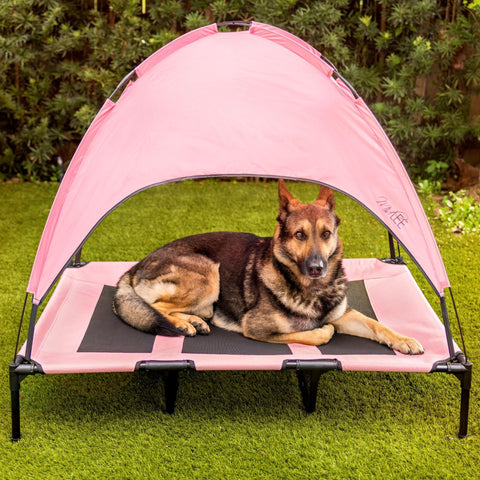So you’ve been thinking about getting an additional bed for your furry friend, but you’re not quite sure if it’s the right decision. Well, fear not! In this article, we’ll explore the pros and cons of having multiple beds for your dog. From providing extra comfort and flexibility to potential challenges of space and training, we’ll cover it all. By the end, you’ll have a clearer understanding of whether adding another bed to your pup’s collection is the pawfect choice for you and your canine companion.

Pros of Having Multiple Beds for Your Dog
Comfort and Support
Having multiple beds for your dog can provide them with the ultimate comfort and support they need. Just like humans, dogs appreciate a cozy place to rest their weary bones. By providing multiple beds throughout your home, you can ensure that your furry friend always has a soft and comfortable spot to curl up and relax. Whether it’s a plush bed in the living room or a cozy crate bed in their designated sleep area, your pup will appreciate the extra comfort and support that multiple beds can offer.
Preventing Joint and Muscle Issues
One of the major benefits of having multiple beds for your dog is the positive impact it can have on their joint and muscle health. Dogs, especially large breeds or those prone to joint issues, can develop painful conditions such as hip dysplasia or arthritis. By providing multiple beds in various areas of your home, you allow your dog to change positions and alleviate pressure on their joints. Different beds with varying levels of firmness can also help distribute their weight more evenly, reducing the risk of developing painful conditions.
Reducing Stress and Anxiety
Just like humans, dogs can experience stress and anxiety. Whether it’s caused by separation anxiety, loud noises, or changes in their environment, having multiple beds can help alleviate their anxiety. Dogs often seek comfort in their beds, and having multiple options allows them to choose a spot that makes them feel the most secure. Whether it’s a quiet corner in the bedroom or a spot by the window to watch the world go by, multiple beds can provide a sense of security and help reduce stress and anxiety in your furry companion.
Promoting Good Sleep
Adequate and quality sleep is crucial for a dog’s overall health and well-being. Having multiple beds allows your pup to find the perfect sleeping spot where they can enjoy uninterrupted sleep. Dogs have different preferences when it comes to sleep surfaces – some may prefer a firm bed while others prefer something softer. By providing multiple beds with different levels of firmness, you can ensure that your dog gets the best sleep possible, promoting their overall health and happiness.
Accommodating Multiple Locations
If your dog spends time in different areas of your home, having multiple beds can be incredibly beneficial. For example, if your pup likes to spend time in your home office while you work, having a bed there can keep them comfortable and content during the day. By strategically placing beds in different rooms, you can accommodate your dog’s desire to be near you while also ensuring they have a comfortable spot to rest no matter where they choose to be.
Protection in Inclement Weather
While dogs are equipped with natural fur coats, they can still be susceptible to extreme weather conditions. Having multiple beds in different locations can provide your furry friend with protection from inclement weather. For instance, during hot summer days, a bed near an air conditioning vent or in a cool basement can help your dog stay cool and comfortable. In colder months, a warm and cozy bed near a fireplace or a heated mat can provide them with the warmth they need. Having multiple beds ensures that your dog has options to seek comfort in any weather condition.
Easy Maintenance and Cleaning
One of the advantages of having multiple beds for your dog is the ease of maintenance and cleaning. Dogs can be messy creatures, and accidents or spills can happen. By having multiple beds, you can simply remove the soiled one and replace it with a clean one while you clean and dry the soiled bed. This eliminates the need for immediate cleaning and allows your dog to always have a clean and fresh bed to enjoy. Additionally, having multiple beds can extend the lifespan of each bed as they won’t be subjected to constant wear and tear.
Promoting Independence
Having multiple beds can also promote independence in your dog. Dogs, like humans, value having their own space and privacy. By providing multiple beds, you give your dog the opportunity to choose where they want to rest, allowing them to have autonomy over their sleeping arrangements. This independence can contribute to your dog’s overall sense of security and confidence.
Accommodating Multiple Dogs
If you have more than one furry friend in your household, having multiple beds becomes even more essential. Dogs, just like humans, may have differing preferences when it comes to sleep surfaces. By providing multiple beds, you can ensure that each dog has a bed that suits their individual needs and preferences. This not only prevents potential conflicts over a single bed but also promotes harmony and peace among your furry companions.
Variety and Options
Last but not least, having multiple beds for your dog gives them a variety of options to choose from. Dogs, like humans, enjoy having choices. By providing beds with different shapes, sizes, and materials, you allow your dog to select the one that suits their mood or preference at any given time. Some dogs may prefer a round bed, while others may enjoy a flat mat or an elevated cot. The variety of options can keep your dog engaged and satisfied, ensuring they always have a place they love to call their own.
Cons of Having Multiple Beds for Your Dog
Cost
One potential drawback of having multiple beds for your dog is the cost associated with it. Quality dog beds can be expensive, and having multiple beds in different areas of your home can quickly add up. However, it’s important to consider the long-term benefits and value that multiple beds provide. Investing in the comfort and well-being of your beloved companion is often worth the initial cost.
Space Constraints
Another downside of having multiple beds for your dog is the space constraints it may present, especially in smaller homes or apartments. Additional beds can take up valuable floor space, making it more difficult to navigate or rearrange furniture. It’s crucial to assess your available space and determine how many beds you can comfortably accommodate without compromising the functionality and flow of your living environment.
Preference and Finickiness
While having multiple beds can cater to your dog’s preferences, it can also enable their finickiness. Some dogs may become choosy and refuse to sleep in certain beds, resulting in even more beds being purchased in the hope of finding the perfect one. It’s important to strike a balance between catering to your dog’s preferences and not reinforcing excessive finickiness that may become a challenge in the long run.
Confusion and Disorientation
Introducing multiple beds into your dog’s routine may sometimes lead to confusion and disorientation. Dogs are creatures of habit and thrive on routine. Having beds in various locations can disrupt their sense of familiarity and cause them to become disoriented or anxious. It’s important to introduce the additional beds gradually and provide consistency and guidance to ensure your dog feels secure and comfortable with the new sleeping options.
Potential for Bed Hoarding
Having multiple beds can inadvertently lead to bed hoarding behavior in dogs. Some dogs may try to claim all the beds as their own, leaving none for their furry siblings or even for you! Bed hoarding can lead to conflicts and power struggles among your dogs. It’s important to establish boundaries and reinforce the idea that each dog has their own designated bed to avoid potential disputes.
Creating Dependency
Another potential downside of having multiple beds is the creation of dependency in your furry friend. Dogs thrive on routine and structure, and having multiple beds can disrupt their sense of stability. By constantly providing different sleeping options, you may inadvertently create a dependency where your dog refuses to sleep or rest without the presence of a specific bed. This can pose challenges when traveling or visiting other locations where their designated bed is not available.
Maintenance and Cleaning
While having multiple beds can ease maintenance and cleaning, it can also become a task in itself. Depending on the size and design of the beds, they may require regular washing, vacuuming, or spot cleaning to keep them fresh and hygienic. With multiple beds, the frequency of cleaning and maintenance increases, requiring more time and effort on your part. It’s essential to consider whether you have the time and resources to consistently maintain and clean multiple beds for your dog.
Risk of Overcrowding
In some cases, having multiple beds for your dog can lead to overcrowding in your living space. Too many beds can make the area cluttered and overwhelming, not only for you but also for your dog. Overcrowding can increase the risk of accidents or injuries as dogs navigate through the tight spaces. It’s essential to strike a balance and ensure that the number of beds you provide is appropriate for the size of your home and the comfort of both you and your furry friends.
Less Space for Human Accommodation
While ensuring your dog’s comfort is important, it’s essential to consider the space requirements for human accommodation as well. Having multiple beds may limit the available space for you and your family members, making it challenging to relax or move around freely. It’s crucial to find a balance between providing comfort for your dog and maintaining a comfortable living environment for yourself and your loved ones.
Inconsistent Training
Introducing multiple beds into your dog’s routine may sometimes lead to inconsistent training. Dogs are creatures of habit, and having multiple beds can disrupt their established habits and training routines. For example, if your dog is used to sleeping in their crate bed at night but you introduce a bed in your bedroom, it may confuse their understanding of where they should sleep. Consistency in training is essential for your dog’s overall behavior and discipline, and multiple beds can potentially undermine that consistency.
In summary, the pros and cons of having multiple beds for your dog should be carefully considered based on your dog’s specific needs and your living situation. While multiple beds can provide comfort, support, and a range of options for your furry friend, they also come with potential drawbacks such as cost, space constraints, and the risk of creating dependency. It’s important to strike a balance and find a solution that works best for you and your beloved companion, ensuring their well-being while also maintaining a harmonious living environment for everyone.





